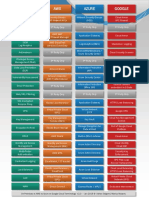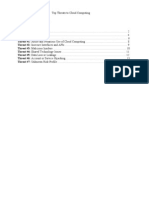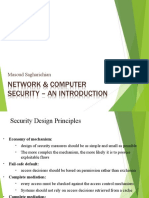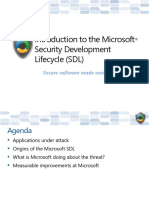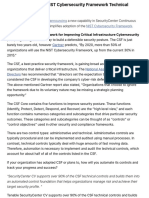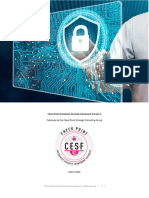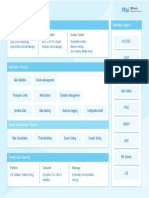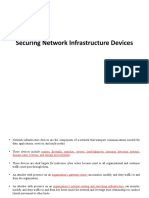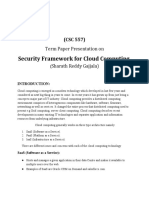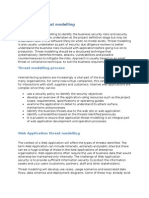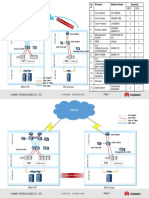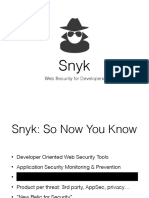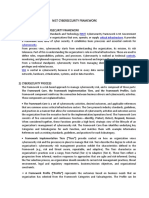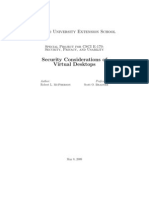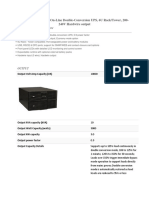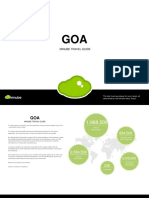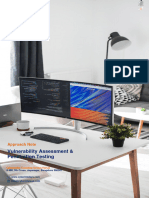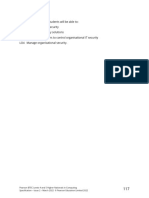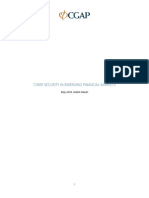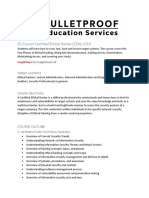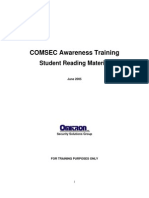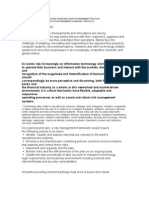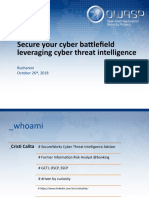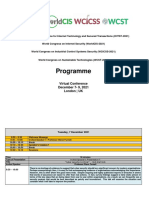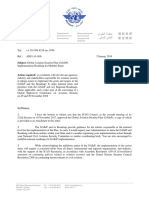Security Solution Architecture for VDI
A reference implementation of VMware View
BE N E F I TS
Validated solution architecture
provides unprecedented
end-to-end security
dashboard for virtual desktop
infrastructure (VDI)
Integrated and tested VMware
and Technology Alliance
Partner solution based on
security and compliance
Highlighted real-time
compliance monitoring and
considerations for auditing
Introduction of security zoning
allows VDI to support multiple
compartments at same
security level
VMware services and
partnerships make it easy to
implement the security
solution template
Desktop Security: An Architectural Approach
The importance of desktop security is magnified in todays increasingly connected, mobile, multidevice business environment. High-profile security breaches such as stolen laptops and compromised
desktops only underscore what IT professionals already know: protecting sensitive data is an
increasingly urgent priority.
The move to virtual desktop infrastructure (VDI) using VMware View is gaining momentum because it
solves some of the most pressing security concerns: all sensitive data is housed in the data center
rather than the desktop; application software is isolated from the operating system; PC software
images are consolidated and access can be controlled more tightly.
However, VDI and VMware View alone cannot resolve all desktop security issues. This brief provides an
overview of the desktop security vulnerabilities which exist in both virtual and physical environments
that must be addressed throughout the typical connection sequence, along with the VMware and thirdparty products that remediate the issues. Together, these products and technologies comprise a
security solution architecture for VDIan architecture that goes beyond the viruses, worms, and
phishing attacks mostly commonly addressed in desktop security technology to include data loss,
system management, and compliance monitoring.
The purpose of this brief is not to provide detailed information about any of the point products
mentioned, but rather to highlight the potential problems and the solutions available, so that VMware View
customers can take the appropriate actions to fully secure their environment and achieve compliance.
Threats and Vulnerabilities
Desktop security is not simply about securing the desktop device. An effective desktop security
architecture must address security vulnerabilities at the user level, the endpoint device level, the
application level, data center level, the network level, and the management level. The diagram
below presents the typical connection sequence in a VMware View environment; the next
sections of this brief describe the specific security vulnerabilities at each phase of the
connection flow and the VMware and third-party products that remediate the issue.
User Files
View
Management Tools
4
Vendor
Management Tools
6
3
5
3
View
Management
Security
Container(s)
Active
Directory
VMware vSphere
7
Figure 1: View Connection Sequence
The connection flow for VMware View can be simply described by the following steps:
1. A VMware View user using View Client connects to the View Security Server and authenticates
REFERENCE GUIDE / 1
�Security Solution Architecture for VDI
2. When a PCoIP desktop is selected, the PCoIP protocol goes
to the View Security Server
R EMEDIATION / SOLU TION
3. If the PCoIP session is on behalf of an authenticated user, it
is then forwarded to the correct desktop
System Management Software VMware vCenter
Configuration Manager (used for OS and application updates
and patches)
4. VMware View management tools are used to provision
desktops and set user access, entitlement and permission
policies
Endpoint Identity Access Two-factor authentication uses
smart card, eToken, biometric sensor, and one-time password
token (secureID token)
5. User data is stored within the data center using the
companys privacy policies and selected encryption
technologies
Vulnerability Monitoring and Scanning Port scanning for
the entire network and real-time vulnerability analysis on
desktops and servers based on a vulnerability database
maintained by ISVs
6. Vendor management tools are used for aggregate desktop
configuration, reporting, and compliance management
Figure 1 illustrates the logical steps of how the connection
interacts with Active Directory and management tools during
desktop access.
Data Encryption Prevention of unauthorized access and
downloads of sensitive data from corporate environment
Untrusted to Trusted Connection
The security practices should address user mobility, since the data
is centrally located and users can access the same data from many
different network nodes. The architecture implementation should
also cover major updates and patches that are applied to every
single desktop and pushed to the entire VDI deployment.
Vulnerabilities and Threats in the Connection Sequence
User Files
View
Management Tools
4
Vendor
Management Tools
6
3
5
End User Authentication
3
View
Management
User Files
View
Management Tools
4
Vendor
Management Tools
6
3
5
Security
Container(s)
VMware vSphere
Active
Directory
VMware vSphere
Figure 3: Untrusted to Trusted Connection
SECU R ITY V U LN ER AB ILITIES
Denial of IP service (DoS) or load balancing
3
View
Management
Security
Container(s)
Active
Directory
Denial of user service (lockout due to too many attempts)
Time-of-Day access for external desktop sessions
Windows server default known vulnerabilities
Figure 2: End User Authentication
S E C UR I T Y V UL N E R A BI LI TI E S
Spoofing user identity
External theft of credentials
(two-factor authentication token)
Hijacking user desktop session
Unsigned certificate can potentially direct user to
a compromised network
Insecure device
R EMEDIATION / SOLU TION
Implement virtual/physical firewalls that can detect and
counter against denial of service (DoS) attacks, and null route
any malicious traffic thats identified as a DoS attack
Allow access to private network from outside as a NAT
device, e.g. VMware vShield Edge
Disable account logon privilege after x failed login attempts
Vulnerability scanning/monitoring real-time crosscheck
known vulnerabilities that affect the OS
REFERENCE GUIDE / 2
�Security Solution Architecture for VDI
Provisioning Desktop
SECU R ITY V U LN ER AB ILITIES
One user viewing another users data
User Files
Data leakage at rest via internal/external cloud
View
Management Tools
Data leakage in motion with user data over network
Vendor
Management Tools
6
3
Data written/stored to USB removable devices
R EMEDIATION / SOLU TION
Data Encryption
3
View
Management
Security
Container(s)
Active
Directory
Uninformed Management Tools
VMware vSphere
User Files
View
Management Tools
Figure 4: Provisioning Desktop
4
S E C U R I T Y V U L N E R ABI LI TI ES
Vendor
Management Tools
Desktops containing known viruses
Desktops not meeting compliance standards
Desktops containing malware/virus propagation and traversal
3
View
Management
Un-patched software/OS with known vulnerability
2
Unmanaged or orphaned VM from pool
R E ME D I AT I O N / SO LUTI O N
Security
Container(s)
Active
Directory
VMware vSphere
Figure 6: Uninformed Management Tools
Create security trust zone to segregate management network
from desktops, e.g. vShield Manager Zone creation
Use system configuration, e.g. vCenter Configuration
Manager, to enforce desktop compliance and updates
Use endpoint protection e.g. vShield Endpoint, to prevent
malware and viruses at desktops
User Data
SECU R ITY V U LN ER AB ILITIES
Virtual machines enter and exit between scheduled scanning
periods without knowledge of user data stored on central
store
Issues underreported by management tools
R EMEDIATION / SOLU TION
vShield Endpoint / Trend Micro Deep Security
vCenter Configuration Manager
User Files
View
Management Tools
4
Vendor
Management Tools
5
3
View
Management
Security
Container(s)
Active
Directory
VMware vSphere
Figure 5: User Data
REFERENCE GUIDE / 3
�Security Solution Architecture for VDI
Desktop Configuration
User Files
vShield (App / Firewall / Edge
View
Management Tools
10.50.63.96/27
(Management Network)
4
Vendor
Management Tools
dVS
Management Cluster
View Prod Cluster
View 5.0
Splunk
Rapid 7
View
Management
Security
Container(s)
Active
Directory
Verdasys Digital Guardian
VMware vSphere
Figure 7: Desktop Configuration
vCM
Doctors VDI Pool
vShield Manager
Nurses VDI Pool
Microsoft
S E C U R I T Y V UL N E R A BI LI TI ES
Desktop host configuration has known threats due to missing
patches or mis-configuration
Kiosk VDI Pool
ESX Host (1)
192.168.1.0/24
(View Desktop LAN)
RE ME D I AT I O N / SO LUTI O N
Corp VDI Pool
Catbird
ESX Host (1)
Define bad traffic flow/user random attempts
Desktop image compliance, e.g. vCenter Configuration Manager
vCenter
Security Practices and Considerations
Security and compliance requirements can slow down the adoption
of a virtual infrastructure. A lack of understanding of the
requirements for business continuity, integrity, and data protection
in a virtualized data center may result in a partial or a complete
failure of the virtual desktop deployment or migration project.
VMware vShield provides a firewall-zoning policy. The addition of
ISV partner security products can be integrated with vShield API
to ensure policy enforcement.
Firewall
IDS/IDP
and
Flow
Monitor
Vulnerability
Management
Layer 2
Access
Control
Virtual
Infrastructure
Monitoring
Auditing
Security Orchestration and Validation for Real-Time
Compliance Measurement and Reporting
Corp
Figure 9: Solution Lab Setup for Simplified VDI Security Architecture
VMware vSphere 5 environments are built for VMware and ISV
management components as well as for desktop pools including
floating and persistent. Inter-network connectivity is managed
using a VMware vSphere Distributed Switch (vDS). The VMware
vShield firewall enforces network access control and vShield Edge
provides security connectivity with the corporate home network.
Security policy definitions are created based on:
Enforcing unauthorized connectivity (e.g. network flow) among
VDI pools
Enforcing network segmentation
Allowing VDI pools with distinct connectivity to share
enterprise-level connectivity
Geographic and network boundaries
Allowing access to shared resources
VDI Pool
Trust Zone
Figure 8: Real-Time Compliance Metrics and Reporting with Multi-Functional Policy
Enforcement
Reducing operations and management costs
Enforcing security isolation between zones
Assigning security policy per zone
Supporting multiple compartments at the same security level
REFERENCE GUIDE / 4
�Security Solution Architecture for VDI
Compliance Monitoring Dashboard
The integrated dashboard from the ISV is designed to provide
IDS/IDP, Vulnerability Management, L2 access control, and
compliance monitoring and auditing. Through an event-driven
risk and compliance dashboard, enterprises can aggregate instant
audit reports and ensure continuous compliance.
Trust Zone
Trust Zone
Doctors
ISV Trust Zones
Membership Automation
and Real-Time Compliance
Firewalll
vShield App Firewall
Enforces Network
Access Controls
Corp
Trust Zone
Firewalll
internet
e t
vShield Edge Provided
Security Connectivity
with Corporate
HOMENetwork
Integrated vCenter Operations Management (vCOPs) Dashboard
The dashboard displays the View access events at SQL or Oracle
database and the syslog events being pulled and populated into
vCOPs via simple expression commands. This integrated
monitoring provides a true an end-to-end VDI security
dashboard. The metrics can include data like Most Recent Logins
by IP (Success/Failed), Logins by Users, Desktop Uptime,
Success/Failed Login Origination, USB Policy etc. vCOPS also
provides the vCM compliance management adapter that your
organization can integrate for any mandates alerts.
Corporate Home Network
Figure 10: Using vShield App and Edge to Define the Geo and Network Boundaries
Figure 11: Integrated Security Dashboard
REFERENCE GUIDE / 5
�Security Solution Architecture for VDI
Figure 12: View Event Manager Default Log
Compliance Template
(HIPAA, SOX, FISMA, PCI, DIACAP, and COBIT)
Compliance requires collection and correlation of data from
multiple technical controls. Every mandate contains different sets
of technical controls. In-depth controls for VDI include the
following:
Inter-network segmentation
Intra-network and inter-VM segmentation
Layer 2/3/4 controls
Together, VMware and partners offer an integrated compliance
dashboard (illustrated below in figures 13 and 14) that provides
security templates allowing for real-time monitoring of the
certification process on VDI designs. For example, the Department
of Defense Information Assurance Certification and Accreditation
Process (DIACAP) ensures that risk management is applied on
information systems. With the compliance dashboard, VDI
customers can analyze and visualize multiple aspects of DIACAP
compliance, including boundary defense, remote access for
privileged functions, remote access for user functions, access for
computing facilities, and so on.
Application layers (5-7) controls
Deep packet controls for most applications
Botnet command and control server (C&C) controls
Malware site controls
Anti-phishing/anti-pharming controls
Integration with VM configuration
Zone-based policy controls
Network change control process
Block metasploit attack
Automated workflow
REFERENCE GUIDE / 6
�Security Solution Architecture for VDI
Summary
Security vendors realize that the enterprise perimeter and desktop security vulnerabilities have changed. Firewalls with basic allow/deny rule
sets, based on IP addresses and application ports, are not flexible enough for the dynamic type of connectivity enterprises required with
outside partners, part-time contractors and guests, as well as an increasingly mobile work force. Perimeter security access technology now
adapts to become more aware of applications, virtual desktop use cases, end-user identity, and enterprise policy.
VMware partner products and solutions integrated with the VMware security framework meet these updated security requirements. A
security solution architecture dashboard easily showcases multiple security aspects and considerations for an end-to-end VDI practice.
The solution architecture presents one of the many security options you can consider, not *the* only option.
Authors
This brief was prepared by the Solution Management Team in the VMware End User Computing business unit. The Solution Management Team
is responsible for architecting and validating both horizontal and vertical solutions that feature VMware View along with requisite partner
products. For this paper, integration efforts were provided by security architects from VMware and teams at our partner organizations.
A summary of the VMware and partner products used in the security architecture for VDI is provided in the chart below.
Security Architecture for VDI: VMware and Partner Products
PA RTNER PRODUCTS
USE CASES IN SECURITY DASHBOARD
Verdasys Digital Guardian
Protection from data loss to USB devices http://www.verdasys.com/
File level monitoring with visibility
File encryption
Network upload monitoring and control
Clipboard, print, printscreen monitoring and controls
REFERENCE GUIDE / 7
